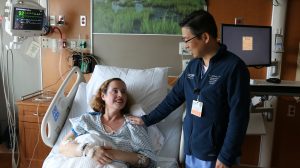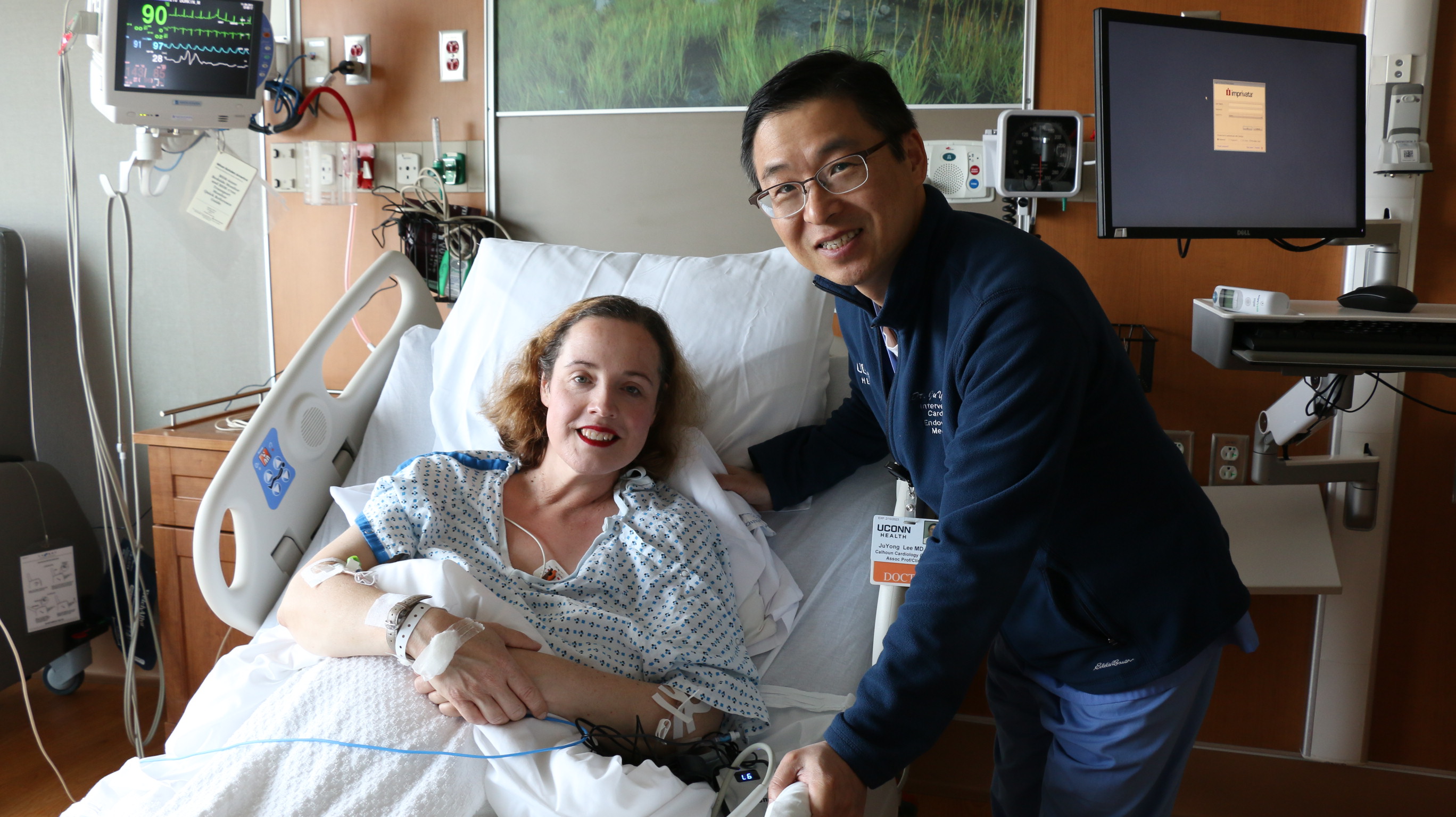Maureen Durkin, 50, of Canton, was raking the fall leaves in her backyard one afternoon this November and thought she pulled a leg muscle.
But a few hours later Durkin suddenly started experiencing shortness of breath, pressure in her chest, a rapid heart rate over 140 beats per minute, trouble walking very short distances inside her home, and even struggled to have enough breath to talk.
She called 9-1-1 and arrived to the Emergency Department at UConn John Dempsey Hospital at UConn Health where she’s been a longtime patient and is currently being treated for Stage 2 breast cancer. She was diagnosed this summer and is currently receiving chemotherapy prior to surgery.
“A rapid CT scan found huge blood clots in both of my lungs and I was immediately whisked to the Cath Lab within fifteen minutes,” says Durkin. “Never would I have thought that a pain in my right leg that I thought was a pulled muscle could lead to such an extremely dangerous medical situation.”
It turns out that Durkin’s symptoms were triggered by a deep vein thrombosis (DVT), or blood clot that formed in her leg that quickly traveled through her heart and ultimately lodged inside both her left and right pulmonary arteries in her lungs. This dangerous and potentially highly fatal condition is known medically as submassive pulmonary embolism.
“The risk for mortality was very high for Maureen’s submassive pulmonary embolism condition if not treated appropriately,” says Dr. Juyong Lee, interventional cardiologist, associate professor of medicine and director of Vascular Medicine and Endovascular Therapy at UConn Health’s Pat and Jim Calhoun Cardiology Center.
Because of her large pulmonary embolisms in her lungs, Durkin was not only experiencing shortness of breath and a rapid heart rate but also the added pressure in her lung vessels from the large blood clots caused her right heart to become enlarged. This was additionally leading to acute right heart failure and the weakened ability of her heart muscle to properly pump blood throughout the body according to Lee.
Durkin was the first patient in the Greater Hartford Area and at UConn John Dempsey Hospital to receive immediate intervention using the newly FDA approved technology for her specific diagnosis of submassive pulmonary embolism. Inside the Calhoun Cardiology Center’s Cardiac Catheterization Laboratory the latest high-tech, minimally invasive catheter system called Flowtreiver was guided through the vein access in Durkin’s groin while she was awake to directly enter her lungs and successfully suck out the dangerous blood clots.

“The new procedure was a really fascinating experience and I immediately felt better,” shared Durkin.
“I am happy to report that thanks to the new innovative technology to perform a percutaneous mechanical thrombectomy Maureen’s shortness of breath and pulmonary artery pressure, along with her heart rate and pumping function normalized immediately after the blood clots were removed from her lungs,” shared Lee. “I am so glad to see her recovering so well, smiling, and already walking around.”
“Dr. Lee was excellent and so was the innovative, painless procedure to remove my large blood clots in my lungs that immediately helped improve my breathing and alleviate the pain in my chest,” says Durkin. “I would recommend Dr. Lee’s care and the new technology to anyone in need.”
Durkin’s strong message to others: “Listen to your body. Never ignore shortness of breath or pain. It could really be something serious your body is trying to alert you about. Also, if you are going through cancer chemotherapy be aware that it puts you at higher risk of experiencing a DVT blood clot.”
Now Durkin will continue to take anticoagulant medication and will be monitored with ultrasound to make sure any DVTs stay at bay as she looks forward to completing her cancer journey.
“Now that I won my battle with DVT and pulmonary embolisms, I no longer have blood clots holding me back and I am looking forward to my next battle – curing my breast cancer.”
According to Lee anyone can experience a DVT, PE blood clot. However, in addition to chemotherapy being a high risk factor for DVT, others include immobilization, prolonged travel, sedentary lifestyle, and obesity.
Lee says our society’s less active lifestyle and the obesity epidemic are leading to an uptick in the DVT and subsequent pulmonary embolism cases medical experts like him are seeing nationally. Sadly, PEs are one of the top leading causes of death of hospitalized patients.
Learn more about the Pat & Jim Calhoun Cardiology Center at UConn Health here.



